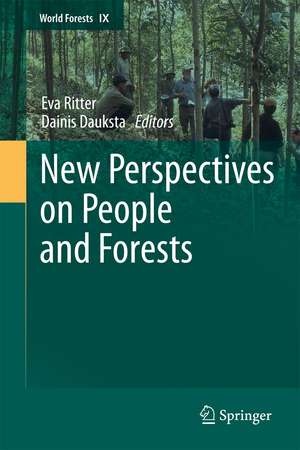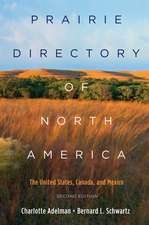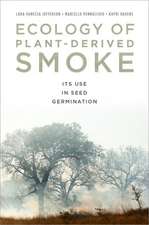New Perspectives on People and Forests: World Forests, cartea 9
Editat de Eva Ritter, Dainis Daukstaen Limba Engleză Paperback – 15 iul 2013
Given the wide range of forest landscapes, and cultural perspectives which exist across the world, the book focuses on Europe as a test case to explore the various relationships between society, culture, forests and landscapes. It looks at historical evidence of the impacts of people on forests and vice versa, explores the current factors affecting people’s physical and emotional comfort in forest landscapes, and looks ahead to how changes in forest cover may alter the present relationships of people to forests.
Drawing together a diverse literature and combining the expertise of natural and social scientists, this book will form a valuable reference for students and researchers working in the fields of landscape ecology and landscape architecture, geography, social science, environmental psychology orenvironmental history. It will also be of interest to researchers, government agencies and practitioners with an interest in issues such as sustainable forest management, sustainable tourism, reserve management, urban planning and environmental interpretation.
| Toate formatele și edițiile | Preț | Express |
|---|---|---|
| Paperback (1) | 943.57 lei 43-57 zile | |
| SPRINGER NETHERLANDS – 15 iul 2013 | 943.57 lei 43-57 zile | |
| Hardback (1) | 947.35 lei 43-57 zile | |
| SPRINGER NETHERLANDS – 6 mai 2011 | 947.35 lei 43-57 zile |
Din seria World Forests
- 15%
 Preț: 646.43 lei
Preț: 646.43 lei - 15%
 Preț: 643.48 lei
Preț: 643.48 lei - 18%
 Preț: 1235.43 lei
Preț: 1235.43 lei - 18%
 Preț: 1225.94 lei
Preț: 1225.94 lei - 15%
 Preț: 631.53 lei
Preț: 631.53 lei - 18%
 Preț: 1233.37 lei
Preț: 1233.37 lei - 18%
 Preț: 947.35 lei
Preț: 947.35 lei - 18%
 Preț: 943.57 lei
Preț: 943.57 lei - 18%
 Preț: 946.41 lei
Preț: 946.41 lei - 18%
 Preț: 953.35 lei
Preț: 953.35 lei - 18%
 Preț: 1559.80 lei
Preț: 1559.80 lei - 15%
 Preț: 644.95 lei
Preț: 644.95 lei - 15%
 Preț: 640.06 lei
Preț: 640.06 lei - 15%
 Preț: 645.60 lei
Preț: 645.60 lei - 18%
 Preț: 1223.55 lei
Preț: 1223.55 lei - 18%
 Preț: 730.35 lei
Preț: 730.35 lei - 18%
 Preț: 1107.56 lei
Preț: 1107.56 lei - 18%
 Preț: 1240.30 lei
Preț: 1240.30 lei - 18%
 Preț: 952.40 lei
Preț: 952.40 lei - 20%
 Preț: 552.12 lei
Preț: 552.12 lei - 18%
 Preț: 954.45 lei
Preț: 954.45 lei - 24%
 Preț: 779.23 lei
Preț: 779.23 lei - 24%
 Preț: 1058.44 lei
Preț: 1058.44 lei
Preț: 943.57 lei
Preț vechi: 1150.70 lei
-18% Nou
Puncte Express: 1415
Preț estimativ în valută:
180.55€ • 188.99$ • 150.28£
180.55€ • 188.99$ • 150.28£
Carte tipărită la comandă
Livrare economică 31 martie-14 aprilie
Preluare comenzi: 021 569.72.76
Specificații
ISBN-13: 9789400736023
ISBN-10: 9400736029
Pagini: 268
Ilustrații: XVIII, 250 p.
Dimensiuni: 155 x 235 x 14 mm
Greutate: 0.39 kg
Ediția:2011
Editura: SPRINGER NETHERLANDS
Colecția Springer
Seria World Forests
Locul publicării:Dordrecht, Netherlands
ISBN-10: 9400736029
Pagini: 268
Ilustrații: XVIII, 250 p.
Dimensiuni: 155 x 235 x 14 mm
Greutate: 0.39 kg
Ediția:2011
Editura: SPRINGER NETHERLANDS
Colecția Springer
Seria World Forests
Locul publicării:Dordrecht, Netherlands
Public țintă
ResearchCuprins
Preface
Content
About the authors
Contributors
PART I
1 Introduction – The crooked timber of humanity
Dainis Dauksta
2 Forests in landscapes – The myth of untouched wilderness
Eva Ritter
2.1 People and forests in prehistoric times
2.1.1 Hunter-gatherers in Europe
2.1.2 The mid-Holocene elm decline
2.1.3 The Great Transition
2.1.4 Early agricultural impacts on forests
2.2 Forest development in historical times
2.2.1 The great deforestation of the Ancient World
2.2.2 Impacts on forests in Northern and Central Europe
2.2.3 Forest protection and forest expansion
2.3 Conclusion
3 Overcoming Physicophobia – Forests as the sacred source of our human origins
Roy Jackson
3.1 The forest as nothing more than useful
3.2 Rousseau: Friend of the forest
3.2.1 The demystification of the forest
3.2.2 The “Savage Man”
3.3 Nietzsche and the sacredness of nature
3.3.1 Nietzsche’s criticism of modernity
3.3.2 Nietzsche’s “religious” experience
3.4 Conclusion
PART II
4 Royal forests – Hunting and other forest use in Medieval England
Della Hooke
4.1 Forests as game reserves
4.1.1 The location of forests
4.1.2 Forest rights and administration
4.2 Medieval hunting
4.2.1 Anglo-Saxon hunting and game reserves
4.2.2 Medieval hunting methods
4.2.3 Hunting iconography in medieval literature
4.3 The use of other forest resources
4.3.1 Forest pasture
4.3.2 Other forest products
4.4 The decline of the forests
4.5 Hunting in post-medieval times
4.6 Conclusion
5 Forests as commons – Changing traditions and governance in Europe
ChristopherShort
5.1 Introduction to the commons
5.2 History of forests as commons in Europe
5.2.1 Northwestern Europe and the Alps
5.2.2 Southern Europe
5.2.3 United Kingdom
5.3 How the role and use of forests is changing
5.4 The relationship between people and forest commons
5.5 Conclusion
6 New forest owners – Small scale forestry and changes in forest ownership
Áine Ní Dhubháin
6.1 What is small-scale forestry?
6.2 Characteristics of small-scale forests
6.3 Owners of small-scale forests
6.3.1 Ownership structure
6.3.2 Objectives of small-scale forest owners
6.4 Nature of small-scale forests
6.5 Consequences of the changing ownership structure
6.5.1 Forest fragmentation
6.5.2 Recreation and access
6.5.3 Timber production
6.5.4 Nature conservation
6.6 Conclusion
7 Forest and recreation – New functions of afforestation as seen in Denmark
Carla K. Smink
7.1 Forest recreation: a policy perspective
7.2 Forest use in Denmark
7.3 Afforestation: creation of recreation opportunities
7.4 Conclusion
PART III
8 From post to pillar – The development and persistence of an arboreal metaphor
Dainis Dauksta
8.1 The wooden post in prehistory and the growth of symbols
8.1.1 Timber circles
8.1.2 Celtic and La Tène sites
8.2 The layering of connected symbols
8.2.1 The anthropomorphic tree
8.2.2 The lopped tree, the axe and the thunder god
8.2.3 The Maypole
8.3 The Classical column
8.4 Two modern vestiges of the sacred pillar
8.5 Conclusion
9 Landscape painting and the forest – The influence of cultural factors in the depiction of trees and forests
Dainis Dauksta
9.1 Medieval symbolic and factual landscapes
9.1.1Symbols of Christ, crucifixion and redemption
9.1.2 Perspective, nature and classical mythology
9.1.3 Hunting, forestry and country life
9.2 Poetic landscapes as concept
9.3 New symbolic and factual landscapes
9.4 Modern transcendentalism and symbolism
9.4.1 David Jones; a coalescence of ancient themes
9.4.2 Modern symbolism: irony, the sacred and the secular
9.5 Conclusion
10 Space and place – Popular perceptions of forests
Carl Griffin
10.1 Space and place
10.1.1 A range of perceptions, a range of perspectives
10.1.2 Understanding popular perceptions of forests
10.2 Forests in the landscape and the popular imagination
10.2.1 Changing meanings, changing contexts
10.2.2 Forests as places apart
10.3 The cultural distinctiveness of forests
10.3.1 Floral and faunal cultures
10.3.2 Everyday cultures
10.4 Conclusions: persistences and reimaginings
11 Materiality and identity – Forests, trees and senses of belonging
Owain Jones
11.1 Introduction
11.2 Identity
11.3 Forests, identity and place
11.3.1 Forests as material places of becoming
11.3.2 Forests of places of (sensed) dwelling
11.4 Forests and practices of identities
11.4.1 Global sense of identity
11.4.2 National sense of identity
11.4.3 Regional sense of identity
11.4.4 Local and individual sense of identity
11.5 Complex and contested identities
11.5.1 Forests as spaces of otherness
11.5.2 Forests as places to lose identity
11.5.3 Forests as places to find identity
11.5.4 Forests: Gender and identity
11.6 Conclusion
12 Definition and concepts – The etymology and use of the concepts forests and landscape
Hanna Byskov Ovesen and Kirsten Krogh Hansen
12.1 The use of concepts
12.2 Forest
12.2.1Etymology
12.2.2 Present use
12.3 Landscape
12.3.1 Etymology
12.3.2 Present use
12.4 Conclusion
PART IV
13 Tree use and landscape changes – Development of a woodland area in Sweden
Mårten Aronsson and Eva Ritter
13.1 The area of Bråbygden
13.2 Tree species in the Bråbygden area
13.2.1 The natural tree vegetation
13.2.2 The function and use of tree species
13.3 Human impact on forests, trees and the landscape
13.3.1 Grazing and browsing
13.3.2 Forest fires and slash-and-burn cultivation
13.3.3 Tar distillation and charcoal production
13.3.4 Pollards and leaf-fodder harvesting
13.3.5 Population growth
13.4 Landscape development during medieval times
13.5 Landscape development since the 18th century
13.5.1 Forest description and forest functions
13.5.2 Landscape development
13.5.3 Land us changes during the 20th century
13.6 Some thoughts about the future
14 Forest landscapes in Europe – Visual characteristics and the role of arboriculture
Eva Ritter
14.1 Landscape perception and analysis
14.1.1 Landscape perception and preferences
14.1.2 Concepts of landscape analysis
14.2 Visual landscape characteristics
14.2.1 Degree of openness
14.2.2 Complexity and contrast
14.3 Tree use and landscape development
14.4 Aesthetics in landscape management
14.5 Conclusion
PART V
15 Conclusions – Towards a symbiotic relationship
Eva Ritter and Dainis Dauksta
15.1 Contradicting forest values
15.2 Changing attitudes and relationships
15.3 Future perspectives
Index
.
Content
About the authors
Contributors
PART I
1 Introduction – The crooked timber of humanity
Dainis Dauksta
2 Forests in landscapes – The myth of untouched wilderness
Eva Ritter
2.1 People and forests in prehistoric times
2.1.1 Hunter-gatherers in Europe
2.1.2 The mid-Holocene elm decline
2.1.3 The Great Transition
2.1.4 Early agricultural impacts on forests
2.2 Forest development in historical times
2.2.1 The great deforestation of the Ancient World
2.2.2 Impacts on forests in Northern and Central Europe
2.2.3 Forest protection and forest expansion
2.3 Conclusion
3 Overcoming Physicophobia – Forests as the sacred source of our human origins
Roy Jackson
3.1 The forest as nothing more than useful
3.2 Rousseau: Friend of the forest
3.2.1 The demystification of the forest
3.2.2 The “Savage Man”
3.3 Nietzsche and the sacredness of nature
3.3.1 Nietzsche’s criticism of modernity
3.3.2 Nietzsche’s “religious” experience
3.4 Conclusion
PART II
4 Royal forests – Hunting and other forest use in Medieval England
Della Hooke
4.1 Forests as game reserves
4.1.1 The location of forests
4.1.2 Forest rights and administration
4.2 Medieval hunting
4.2.1 Anglo-Saxon hunting and game reserves
4.2.2 Medieval hunting methods
4.2.3 Hunting iconography in medieval literature
4.3 The use of other forest resources
4.3.1 Forest pasture
4.3.2 Other forest products
4.4 The decline of the forests
4.5 Hunting in post-medieval times
4.6 Conclusion
5 Forests as commons – Changing traditions and governance in Europe
ChristopherShort
5.1 Introduction to the commons
5.2 History of forests as commons in Europe
5.2.1 Northwestern Europe and the Alps
5.2.2 Southern Europe
5.2.3 United Kingdom
5.3 How the role and use of forests is changing
5.4 The relationship between people and forest commons
5.5 Conclusion
6 New forest owners – Small scale forestry and changes in forest ownership
Áine Ní Dhubháin
6.1 What is small-scale forestry?
6.2 Characteristics of small-scale forests
6.3 Owners of small-scale forests
6.3.1 Ownership structure
6.3.2 Objectives of small-scale forest owners
6.4 Nature of small-scale forests
6.5 Consequences of the changing ownership structure
6.5.1 Forest fragmentation
6.5.2 Recreation and access
6.5.3 Timber production
6.5.4 Nature conservation
6.6 Conclusion
7 Forest and recreation – New functions of afforestation as seen in Denmark
Carla K. Smink
7.1 Forest recreation: a policy perspective
7.2 Forest use in Denmark
7.3 Afforestation: creation of recreation opportunities
7.4 Conclusion
PART III
8 From post to pillar – The development and persistence of an arboreal metaphor
Dainis Dauksta
8.1 The wooden post in prehistory and the growth of symbols
8.1.1 Timber circles
8.1.2 Celtic and La Tène sites
8.2 The layering of connected symbols
8.2.1 The anthropomorphic tree
8.2.2 The lopped tree, the axe and the thunder god
8.2.3 The Maypole
8.3 The Classical column
8.4 Two modern vestiges of the sacred pillar
8.5 Conclusion
9 Landscape painting and the forest – The influence of cultural factors in the depiction of trees and forests
Dainis Dauksta
9.1 Medieval symbolic and factual landscapes
9.1.1Symbols of Christ, crucifixion and redemption
9.1.2 Perspective, nature and classical mythology
9.1.3 Hunting, forestry and country life
9.2 Poetic landscapes as concept
9.3 New symbolic and factual landscapes
9.4 Modern transcendentalism and symbolism
9.4.1 David Jones; a coalescence of ancient themes
9.4.2 Modern symbolism: irony, the sacred and the secular
9.5 Conclusion
10 Space and place – Popular perceptions of forests
Carl Griffin
10.1 Space and place
10.1.1 A range of perceptions, a range of perspectives
10.1.2 Understanding popular perceptions of forests
10.2 Forests in the landscape and the popular imagination
10.2.1 Changing meanings, changing contexts
10.2.2 Forests as places apart
10.3 The cultural distinctiveness of forests
10.3.1 Floral and faunal cultures
10.3.2 Everyday cultures
10.4 Conclusions: persistences and reimaginings
11 Materiality and identity – Forests, trees and senses of belonging
Owain Jones
11.1 Introduction
11.2 Identity
11.3 Forests, identity and place
11.3.1 Forests as material places of becoming
11.3.2 Forests of places of (sensed) dwelling
11.4 Forests and practices of identities
11.4.1 Global sense of identity
11.4.2 National sense of identity
11.4.3 Regional sense of identity
11.4.4 Local and individual sense of identity
11.5 Complex and contested identities
11.5.1 Forests as spaces of otherness
11.5.2 Forests as places to lose identity
11.5.3 Forests as places to find identity
11.5.4 Forests: Gender and identity
11.6 Conclusion
12 Definition and concepts – The etymology and use of the concepts forests and landscape
Hanna Byskov Ovesen and Kirsten Krogh Hansen
12.1 The use of concepts
12.2 Forest
12.2.1Etymology
12.2.2 Present use
12.3 Landscape
12.3.1 Etymology
12.3.2 Present use
12.4 Conclusion
PART IV
13 Tree use and landscape changes – Development of a woodland area in Sweden
Mårten Aronsson and Eva Ritter
13.1 The area of Bråbygden
13.2 Tree species in the Bråbygden area
13.2.1 The natural tree vegetation
13.2.2 The function and use of tree species
13.3 Human impact on forests, trees and the landscape
13.3.1 Grazing and browsing
13.3.2 Forest fires and slash-and-burn cultivation
13.3.3 Tar distillation and charcoal production
13.3.4 Pollards and leaf-fodder harvesting
13.3.5 Population growth
13.4 Landscape development during medieval times
13.5 Landscape development since the 18th century
13.5.1 Forest description and forest functions
13.5.2 Landscape development
13.5.3 Land us changes during the 20th century
13.6 Some thoughts about the future
14 Forest landscapes in Europe – Visual characteristics and the role of arboriculture
Eva Ritter
14.1 Landscape perception and analysis
14.1.1 Landscape perception and preferences
14.1.2 Concepts of landscape analysis
14.2 Visual landscape characteristics
14.2.1 Degree of openness
14.2.2 Complexity and contrast
14.3 Tree use and landscape development
14.4 Aesthetics in landscape management
14.5 Conclusion
PART V
15 Conclusions – Towards a symbiotic relationship
Eva Ritter and Dainis Dauksta
15.1 Contradicting forest values
15.2 Changing attitudes and relationships
15.3 Future perspectives
Index
.
Recenzii
From the reviews:
“The book is the exploration of the cultural, biological, spiritual, economic, and emotional components of the forested landscape of northern Europe from the earliest records of interactions between humans and forests to the present day. … This volume should certainly be considered as part of the literature of landscape ecology, as it considers throughout the interactions between humans, forests, and forested landscapes. … For those with a humanistic or philosophical bent, it is likely a worthwhile read … .” (Ralph E. J. Boerner, Landscape Ecology, Vol. 27, 2012)
“The book is the exploration of the cultural, biological, spiritual, economic, and emotional components of the forested landscape of northern Europe from the earliest records of interactions between humans and forests to the present day. … This volume should certainly be considered as part of the literature of landscape ecology, as it considers throughout the interactions between humans, forests, and forested landscapes. … For those with a humanistic or philosophical bent, it is likely a worthwhile read … .” (Ralph E. J. Boerner, Landscape Ecology, Vol. 27, 2012)
Textul de pe ultima copertă
The aim of this book is to elucidate the role of forests as part of a landscape in the life of people. Most landscapes today are cultural landscapes that are influenced by human activity and that in turn have a profound effect on our understanding of and identification with a place. The book proposes that a better understanding of the bond between people and forests as integrated part of a landscape may be helpful in landscape planning, and may contribute to the discussion of changes in forest cover which has been motivated by land use changes, rural development and the global climate debate. To this end, people’s perception of forest landscapes, the reasons for different perceptions, and future perspectives are discussed.
Given the wide range of forest landscapes, and cultural perspectives which exist across the world, the book focuses on Europe as a test case to explore the various relationships between society, culture, forests and landscapes. It looks at historical evidence of the impacts of people on forests and vice versa, explores the current factors affecting people’s physical and emotional comfort in forest landscapes, and looks ahead to how changes in forest cover may alter the present relationships of people to forests.
Drawing together a diverse literature and combining the expertise of natural and social scientists, this book will form a valuable reference for students and researchers working in the fields of landscape ecology and landscape architecture, geography, social science, environmental psychology or environmental history. It will also be of interest to researchers, government agencies and practitioners with an interest in issues such as sustainable forest management, sustainable tourism, reserve management, urban planning and environmental interpretation.
Given the wide range of forest landscapes, and cultural perspectives which exist across the world, the book focuses on Europe as a test case to explore the various relationships between society, culture, forests and landscapes. It looks at historical evidence of the impacts of people on forests and vice versa, explores the current factors affecting people’s physical and emotional comfort in forest landscapes, and looks ahead to how changes in forest cover may alter the present relationships of people to forests.
Drawing together a diverse literature and combining the expertise of natural and social scientists, this book will form a valuable reference for students and researchers working in the fields of landscape ecology and landscape architecture, geography, social science, environmental psychology or environmental history. It will also be of interest to researchers, government agencies and practitioners with an interest in issues such as sustainable forest management, sustainable tourism, reserve management, urban planning and environmental interpretation.
Caracteristici
Contributes to the ongoing discussion on afforestation by including a socio-cultural aspect Deals with important topics in landscape ecology (eg cultural landscapes) Well connected with other important issues like microclimate and human comfort in forest landscapes Explores links between people and forest landscapes which is something that crosses disciplines and few people (if any) have done it successfully Interesting, important and relevant field. People are essential and are all too often forgotten in work on forests and/or forest landscapes Includes supplementary material: sn.pub/extras











